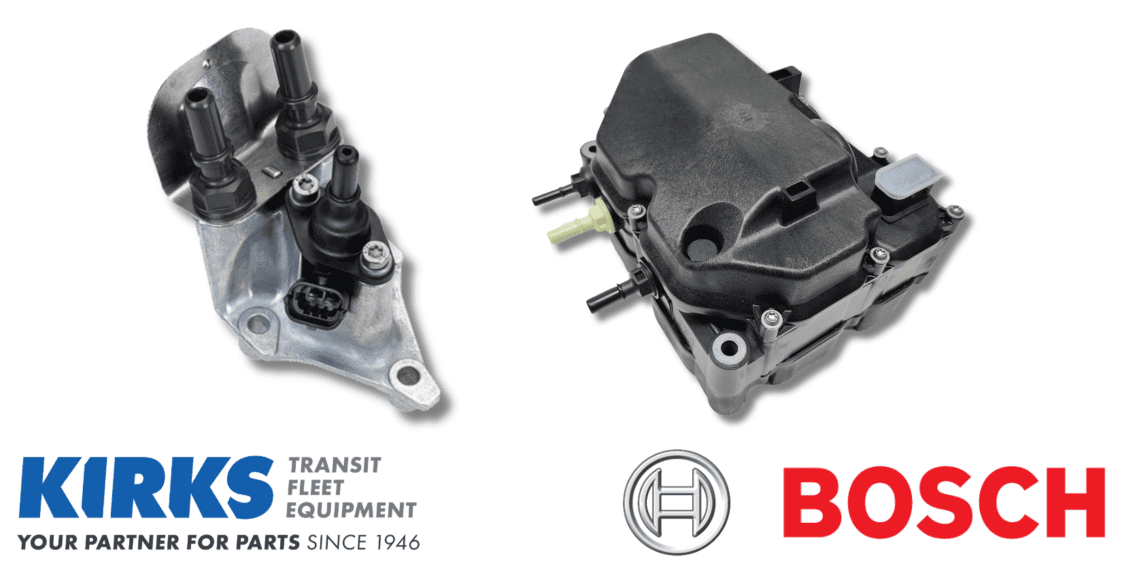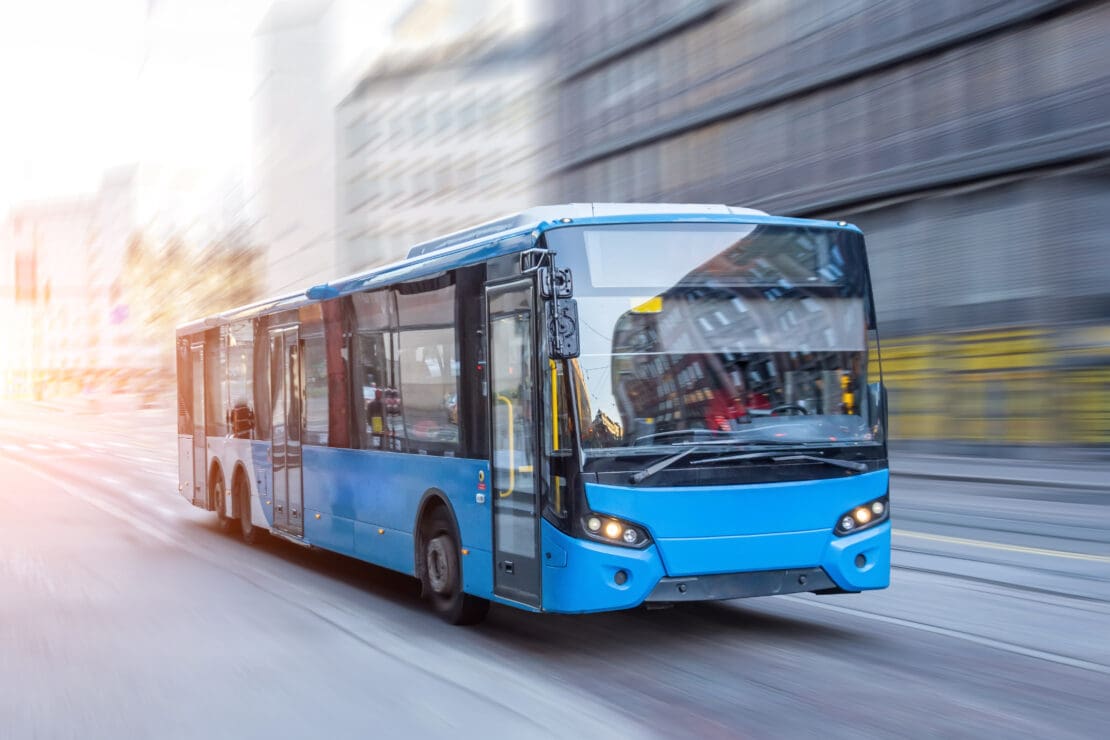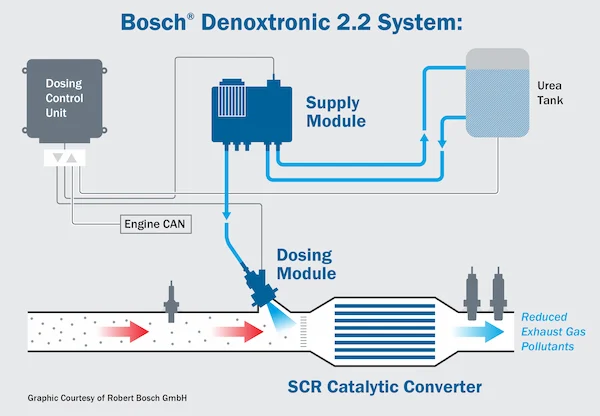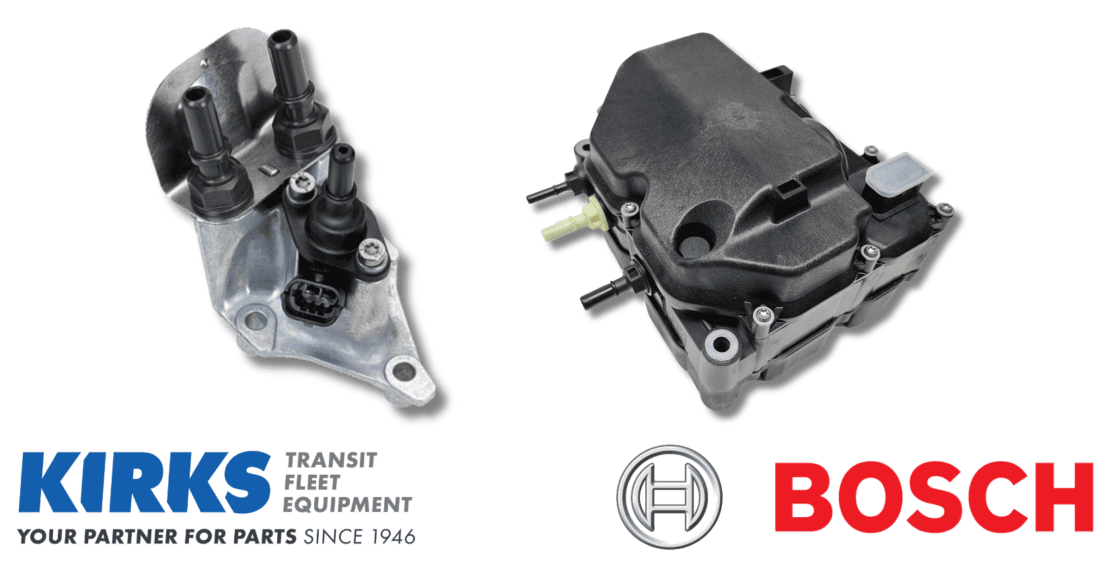
Dependable Dosing and Superior Supply: BOSCH Keeps It Flowing with Denoxtronic 2.2 System for Heavy-Duty and Off-Highway Vehicle Emissions Control
Advancements in diesel emissions technology, like the BOSCH Denoxtronic 2.2 System, have propelled the rise of near-zero-emission trucks and revolutionized U.S. transportation. These cutting-edge improvements dominate the roads today. Since 2010, around 95% of Class 8 commercial trucks have relied on tech using powerful particulate filters and innovative catalytic reduction systems.
In this BOSCH Product Spotlight, we highlight two leading technology solutions in heavy-duty applications that achieve optimal emissions results and uncover the role catalytic reduction plays in reducing harmful discharges.

Decoding Diesel Emissions Reduction: An Overview of How It Works
Several emissions system components work in tandem to control releases of nitrogen oxides (NOx), particulate matter, carbon monoxide, and hydrocarbons into the atmosphere. These components range from exhaust-gas recirculation (EGR) systems on the engine’s front end to after-treatment systems on the back end.
The back-end after-treatment system cleans diesel exhaust gasses using a selective catalytic reduction (SCR) system. The SCR system uses a catalytic converter treated with urea-based diesel exhaust fluid (DEF) to reduce NOx emissions. This system provides the technology needed for compliance with the Environmental Protection Agency’s 2010 Heavy-Duty Highway Engines and Vehicle emissions regulations.
When considering replacement parts, you want to understand how these components work together and which manufacturers have a history of providing trusted solutions. A well-maintained emissions system prolongs engine life and reduces maintenance costs.
How Do SCR Systems Use DEF to Achieve Cleaner Diesel Emissions?
Diesel exhaust fluid (DEF) is a urea and deionized water solution used in diesel engines equipped with SCR systems. DEF is a mix of 32.5% synthetic urea and 67.5% deionized water. Once it is injected into the hot exhaust stream, the DEF is converted into ammonia, breaking the gas into nitrogen and water vapor.
The SCR system contains two main components: the supply and dosing modules.
The Critical Role of the Supply Module
The supply module is the backbone of the SCR system as it ensures a seamless flow of DEF under varying engine conditions.
First, a control module calculates the dosing rate based on engine conditions. Then, the supply module delivers the pressurized DEF solution from a supply tank to the dosing module. In freezing climates, most commercial vehicles also have a DEF heating system to keep them operating optimally in colder temperatures.
The Dosing Module Performs the Exhaust-Gas Treatment
The dosing module determines the precise amount of DEF needed based on engine emissions. It then injects the measured fluid in a compressed state into the exhaust system’s SCR catalyst. This spray triggers the breakdown of NOx emissions.
How Much DEF is Needed to Prevent Excessive Tailpipe Pollutants?
Only the correct quantity of DEF should be atomized and injected into the exhaust stream for engine health. If dosing is incorrect, it can lead to these potential issues:
- An excessive amount of DEF can overwhelm the SCR catalyst. When saturated, the catalyst is less effective in converting NOx emissions and may reduce engine performance.
- Excess DEF can also lead to crystallization and build-up within the system. Crystallization may cause blockages or damage to the injector and other components. The result is malfunction, warning lights, and even engine shutdowns.
To avoid these problems, follow the manufacturer’s guidelines on the recommended amount of fluid. Regular maintenance and monitoring of DEF levels are also crucial to proper functioning and avoiding potential issues.

Why is the BOSCH Denoxtronic 2.2 System the Most Common Heavy-Duty Application in North America?
BOSCH is a global leader in automotive technology. They offer a range of innovative supply and dosing modules specially designed for bus, transit, and other heavy-duty applications.
Nearly 15 years ago, BOSCH rolled out its Denoxtronic line of diesel systems to provide essential components for maintaining emission standards. These cutting-edge modules streamline maintenance processes and ensure vehicles’ optimal performance and longevity.
- Versions: The most common North American versions are Denoxtronic 3.1 (light commercial vehicles, available since 2008) and 2.2 (heavy commercial vehicles, available since 2009).
- Global Adoption: Manufacturers worldwide use BOSCH systems to ensure diesel vehicles adhere to emission limits.
What Are the Advantages of BOSCH Supply and Dosing Replacement Parts for Heavy-Duty Diesel Engine Maintenance?
The Denoxtronic 2.2 system consists of these three components:
- Supply Module – provides the DEF solution. Key features of the BOSCH supply module include:
- Ensuring maximum system reliability in the most adverse driving situations.
- It precisely calculates and measures the flow rate needed by the dosing module to meet EPA requirements.
- Dosing Module – controls and injects diesel exhaust fluids, such as AdBlue® into the exhaust gas stream. Here’s a brief description of BOSCH’s solution:
- The device provides precise dosing using droplet size and feed rate parameters to fit specific treatment situations. These parameters ensure maximum ammonia conversion to enhance SCR efficiency.
- Robust design provides an impressive service life of up to 35,000 hours.
- An active water-cooling system allows operation at temperatures up to 400°F for installation near the engine.
- The design allows straightforward integration into any vehicle.
- SCR Catalytic Converter – receives and processes the injected DEF, reducing NOx emissions.

The Denoxtronic 2.2 system provides cross-vehicle flexibility and adaptability not found with other OEMs:
- BOSCH has designed its supply and dosing modules so that one part number for each module works with multiple CUMMINS engines.
- BOSCH products support a range of heavy-duty vehicles, including CAT, CUMMINS, Isuzu, Mack, Volvo, and others.
You can see more benefits of new and reman BOSCH supply and dosing modules in this post. For a clear animation of the Denoxtronic 2.2 system, BOSCH has a video that highlights the technology here.
Kirks Provides the Parts to Keep Your Heavy-Duty Diesel Vehicles on the Road
By purchasing new and reman BOSCH replacement parts through KIRKS, you save the second and third-party markups of our competitors. We provide personal service and easy-to-order solutions for products directly from leading manufacturers.
Contact us, and a KIRKS product specialist will help you quickly navigate the complex replacement parts maze.
Escape the parts trap with KIRKS OEM and Approved Equal™ parts for transit, motorcoach, school bus, and heavy-duty industrial and municipal fleets.
